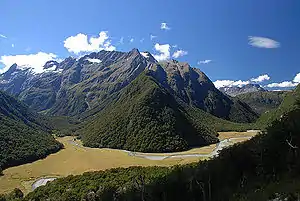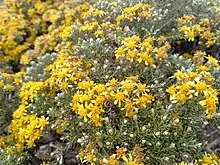| Asterivora exocha | |
|---|---|
 | |
| Male holotype | |
| Scientific classification | |
| Domain: | Eukaryota |
| Kingdom: | Animalia |
| Phylum: | Arthropoda |
| Class: | Insecta |
| Order: | Lepidoptera |
| Family: | Choreutidae |
| Genus: | Asterivora |
| Species: | A. exocha |
| Binomial name | |
| Asterivora exocha | |
| Synonyms[2] | |
| |
Asterivora exocha is a species of moth in the family Choreutidae.[1] It was first described by Edward Meyrick in 1907 and is endemic to New Zealand. This species has only been observed in the Humboldt Ranges of Otago and inhabits subalpine native bush at elevations of around 3600 ft. Adults of this species are on the wing in December and January and have been observed flying at dusk.
Taxonomy
This species was first described by Edward Meyrick in 1907, using a specimen collected by George Hudson at the Humboldt Range, Lake Wakatipu at 3,600 ft, and named Simaethis exocha.[3] In 1928 George Hudson discussed and illustrated this species under that name in his book The butterflies and moths of New Zealand.[4] In 1979 J. S. Dugdale placed this species within the genus Asterivora.[5] In 1988 Dugdale confirmed this placement.[2] The male holotype specimen, collected in the Humboldt Mountains, is held at the Natural History Museum, London.[2]
Description
.jpg.webp)
Meyrick described this species as follows:
♂. 20 mm. Head, palpi, and thorax grey-whitish mixed with blackish. Antennae pale grey, ringed with blackish. Abdomen fuscous, segmental margins mixed with whitish. Fore-wings elongate, moderate, posteriorly rather dilated, costa gently arched, apex obtuse, termen faintly sinuate, oblique; 7 and 8 connate; olive-fuscous, costa and dorsum broadly suffused with dark fuscous; basal area irrorated with whitish except a narrow fascia preceding first line; first line whitish, acutely angulated near costa, followed by a very irregular fascia of whitish irroration, which sends a triangular projection above middle to centre of disc; second line white, sharply defined, running from middle of costa to 3⁄4 of disc, thence acutely angulated to beyond middle of dorsum, somewhat sinuate inwards towards costa and dorsum; an evenly broad fascia of white irroration from 4⁄5 of costa to 4⁄5 of dorsum, resting on second line in discal portion, terminating in a white spot on costa, and edged with a white line from this to angle of second line: cilia grey mixed with whitish, and indistinctly barred with dark fuscous irroration. Hindwings grey, darker posteriorly; indications of a cloudy whitish dot towards termen below middle; cilia grey mixed with whitish, with dark grey basal line.[3]
Distribution

This species is endemic to New Zealand and has been observed in the Humboldt Range near Lake Wakatipu.[3][4]
Habitat
This species inhabits subalpine bush containing Hebe species at elevations of approximately 3600 ft.[4]
Host

The larval host of this species is Brachyglottis cassinioides.[6]
Behaviour
Adults of this species are on the wing in December and January.[7][4] They have been observed to fly at dusk.[4]
References
- 1 2 Gordon, Dennis P., ed. (2010). New Zealand inventory of biodiversity: Kingdom animalia: chaetognatha, ecdysozoa, ichnofossils. Vol. 2. p. 457. ISBN 978-1-877257-93-3. OCLC 973607714. OL 25288394M. Wikidata Q45922947.
- 1 2 3 John Stewart Dugdale (23 September 1988). "Lepidoptera - annotated catalogue, and keys to family-group taxa". Fauna of New Zealand. Department of Scientific and Industrial Research. 14: 113. doi:10.7931/J2/FNZ.14. ISSN 0111-5383. Wikidata Q45083134.
- 1 2 3 Edward Meyrick (June 1907). "Notes and descriptions of Lepidoptera". Transactions and Proceedings of the New Zealand Institute. 39: 120–121. ISSN 1176-6158. Wikidata Q110404133.
- 1 2 3 4 5 George Vernon Hudson (1928), The butterflies and moths of New Zealand, Illustrator: George Hudson, Wellington: Ferguson and Osborn Limited, p. 307, LCCN 88133764, OCLC 25449322, Wikidata Q58593286
- ↑ J. S. Dugdale (July 1979). "A new generic name for the New Zealand species previously assigned to Simaethis auctorum (Lepidoptera: Choreutidae), with description of a new species". New Zealand Journal of Zoology. 6 (3): 461–466. doi:10.1080/03014223.1979.10428386. ISSN 0301-4223. Wikidata Q54576372.
- ↑ Peat, Neville; Patrick, Brian (2001). Wild rivers : discovering the natural history of Central South Island. Dunedin, N.Z.: University of Otago Press. p. 95. ISBN 1-877276-15-4. OCLC 49209579.
{{cite book}}: CS1 maint: date and year (link) - ↑ "Asterivora exocha AMNZ14024". Auckland Museum Collections Online. 22 November 2002. Archived from the original on 2022-02-04. Retrieved 4 February 2022.